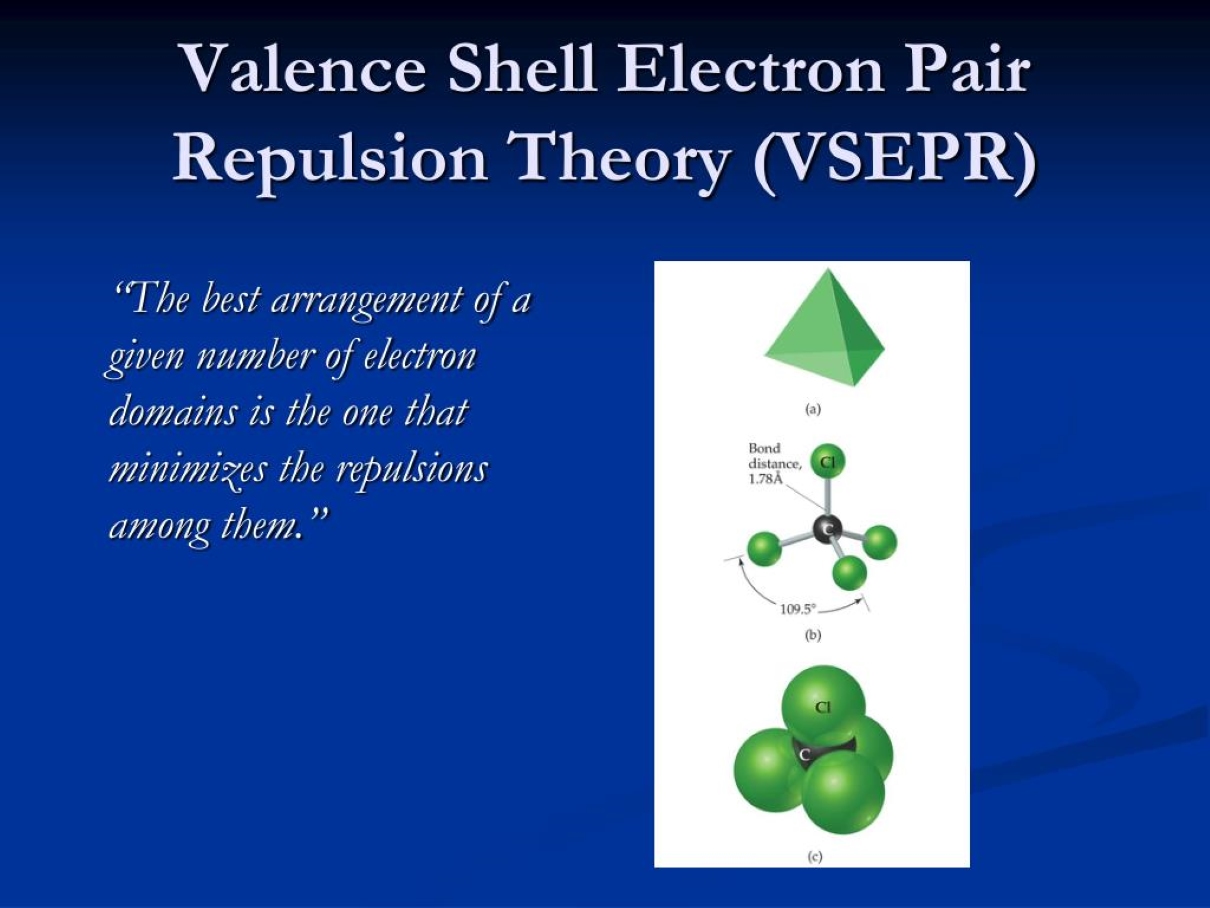
Valence Shell Electron Pair Repulsion (VSEPR) theory is a fundamental concept in the field of chemistry that allows us to predict the shape and geometry of molecules. Developed by Ronald Gillespie and Ronald Nyholm in the 1950s, VSEPR theory revolutionized our understanding of molecular structure. It is based on the idea that electron pairs around a central atom repel each other, resulting in specific geometric arrangements.
In this article, we will explore 19 extraordinary facts about VSEPR theory that will broaden your understanding of how molecules behave. From the foundational principles to real-life applications, these facts will showcase the significance of VSEPR theory in various chemical phenomena.
So, fasten your seatbelts and get ready for a captivating journey into the intricacies of Valence Shell Electron Pair Repulsion theory!
Key Takeaways:
- VSEPR theory helps chemists predict the shapes of molecules by considering the repulsion between electron pairs, making it essential for understanding chemical reactions and molecular structures.
- Understanding VSEPR theory is crucial for students studying chemistry, as it forms the foundation for grasping chemical bonding principles and shapes of organic and inorganic molecules.
VSEPR theory is a fundamental concept in chemistry.
The VSEPR theory, which stands for Valence Shell Electron Pair Repulsion, explains the arrangement of molecules based on the repulsion between electron pairs in the valence shell of atoms.
VSEPR theory was developed by Ronald Gillespie and Ronald Nyholm.
In the 1950s, chemists Ronald Gillespie and Ronald Nyholm independently proposed the VSEPR theory as a way to predict and understand the geometric shapes of molecules.
VSEPR theory helps in predicting molecular shapes.
By considering the number of electron pairs around the central atom and their repulsion, VSEPR theory allows us to determine the most stable arrangement and predict the shape of a molecule.
Electron pairs in VSEPR theory can be bonding or non-bonding.
VSEPR theory takes into account both the bonding electron pairs and non-bonding electron pairs around the central atom to determine the molecular geometry.
The electron pairs in VSEPR theory repel each other to minimize energy.
According to VSEPR theory, electron pairs try to stay as far apart from each other as possible in order to minimize electrostatic repulsion, resulting in specific molecular shapes.
VSEPR theory explains the shapes of molecules such as tetrahedral, trigonal planar, and linear.
VSEPR theory can accurately predict the shapes of various molecules, including tetrahedral (four surrounding atoms), trigonal planar (three surrounding atoms), and linear (two surrounding atoms).
Lone pairs affect the molecular geometry in VSEPR theory.
In VSEPR theory, lone pairs of electrons exert greater repulsion than bonding pairs, which can alter the predicted molecular shape.
VSEPR theory can explain the polarity of molecules.
Based on the arrangement of electron pairs around the central atom, VSEPR theory also helps determine whether a molecule is polar or non-polar.
The VSEPR theory covers both small and large molecules.
Whether it’s a simple diatomic molecule or a complex organic compound, the VSEPR theory can be applied to determine the molecular shape and geometry.
VSEPR theory is useful in understanding chemical reactions.
By knowing the shape and arrangement of atoms in a molecule, chemists can gain insights into the reactivity and behavior of substances during chemical reactions.
The VSEPR theory is a widely accepted model in chemistry.
VSEPR theory is taught and applied in chemistry classrooms worldwide due to its simplicity, effectiveness, and accuracy in predicting molecular shapes.
VSEPR theory can be used to explain the structures of biological molecules.
The VSEPR theory is not limited to inorganic compounds but is also applicable in understanding the molecular structures of complex biological molecules such as proteins and DNA.
The VSEPR theory is supported by experimental data and observations.
Experimental results, such as X-ray crystallography and spectroscopy, have provided evidence that supports the predictions made by the VSEPR theory.
VSEPR theory can be expanded with hybridization.
By incorporating the concept of hybridization, the VSEPR theory can explain the molecular shapes of compounds with multiple bonds.
The VSEPR theory is the foundation for molecular orbital theory.
VSEPR theory provides the basis for understanding molecular orbital theory, which explains the behavior of electrons in molecules and the formation of chemical bonds.
VSEPR theory has applications in various fields.
From drug design to materials science, the VSEPR theory is utilized in different branches of chemistry to analyze and predict molecular structures and properties.
VSEPR theory is essential in the study of organic chemistry.
In organic chemistry, the VSEPR theory is crucial for comprehending the shapes, conformations, and reactions of organic molecules.
Understanding VSEPR theory is key to mastering chemical bonding.
By grasping the concepts of VSEPR theory, students can better understand the principles of chemical bonding and the structure-function relationships in different compounds.
Continued research in VSEPR theory expands its applications in modern chemistry.
Scientists are continually exploring the boundaries of VSEPR theory, leading to further insights and advancements in areas such as materials science, nanotechnology, and catalysis.
These 19 extraordinary facts about Valence Shell Electron Pair Repulsion (VSEPR) demonstrate the significance and versatility of this fundamental concept in chemistry. Understanding VSEPR theory is crucial for predicting molecular shapes, determining polarity, and comprehending the behavior of various compounds. Whether you’re studying inorganic or organic chemistry, the principles of VSEPR theory will undoubtedly play a vital role in your scientific journey.
Conclusion
In conclusion, Valence Shell Electron Pair Repulsion (VSEPR) theory is a fundamental concept in chemistry that allows scientists to predict molecular shapes based on the repulsion between electron pairs in the valence shell of an atom. Through the understanding of VSEPR theory, chemists can determine the geometry, polarity, and bond angles in chemical compounds. This knowledge is crucial in various fields, including drug discovery, materials science, and environmental research.
By applying VSEPR theory, scientists have been able to unravel the intricate arrangement of atoms in molecules and understand how these arrangements affect chemical reactivity and properties. The extraordinary facts about VSEPR covered in this article shed light on its importance in understanding the molecular world.
As our knowledge of chemistry continues to evolve, ongoing research and advancements in computational methods will further refine the VSEPR theory and its applications. The study of VSEPR and its principles will continue to play a vital role in expanding our understanding of the chemical world.
FAQs
Q: What is VSEPR theory?
A: VSEPR theory is a model used in chemistry to predict the shape of molecules by considering the repulsion between valence shell electron pairs.
Q: Why is VSEPR theory important?
A: VSEPR theory is important because it allows scientists to understand the three-dimensional arrangement of atoms in molecules, which determines their chemical and physical properties.
Q: How does VSEPR theory work?
A: VSEPR theory states that electron pairs in the valence shell of an atom repel each other and therefore try to be as far apart as possible, leading to specific molecular shapes.
Q: Can VSEPR theory predict bond angles?
A: Yes, VSEPR theory can predict bond angles by considering the repulsion between electron pairs and the shape of the molecule.
Q: What are some examples of molecular shapes predicted by VSEPR theory?
A: Some common molecular shapes predicted by VSEPR theory include linear, trigonal planar, tetrahedral, trigonal bipyramidal, and octahedral.
Q: Can VSEPR theory be applied to all molecules?
A: VSEPR theory is a simplified model and may have limitations in predicting the shapes of complex molecules or those with unusual electron pair arrangements.
Exploring the fascinating world of chemistry doesn't stop with VSEPR theory. Dive deeper into the intricacies of valence electrons, which play a crucial role in chemical bonding. Uncover the secrets behind molecular shapes and how they influence the properties of compounds. Lastly, prepare to be amazed by the mind-boggling facts surrounding chemical bonding, the very foundation of matter as we know it. Embark on this thrilling journey through the realm of chemistry and expand your knowledge like never before!
Was this page helpful?
Our commitment to delivering trustworthy and engaging content is at the heart of what we do. Each fact on our site is contributed by real users like you, bringing a wealth of diverse insights and information. To ensure the highest standards of accuracy and reliability, our dedicated editors meticulously review each submission. This process guarantees that the facts we share are not only fascinating but also credible. Trust in our commitment to quality and authenticity as you explore and learn with us.


